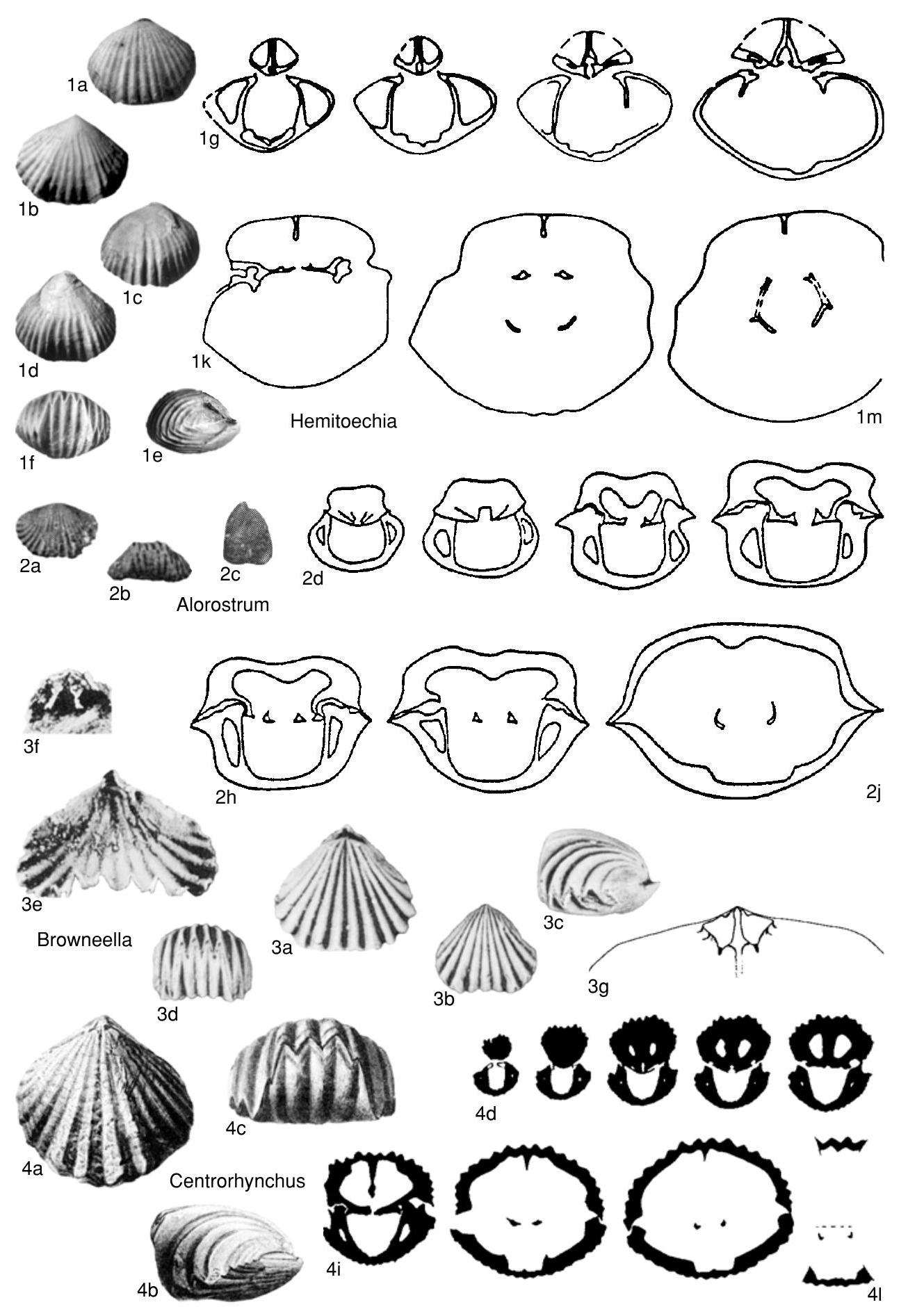Welcome to the Treatise on Invertebrate Paleontology!
Please enter a genera name to retrieve more information.

Centrorhynchus
Classification
Phylum:
Brachiopoda
Subphylum:
Rhynchonelliformea
Class:
Rhynchonellata
Order:
Rhynchonellida
Superfamily:
Rhynchotrematoidea
Family:
Trigonirhynchiidae
Subfamily:
Hemitoechiinae
Formal Genus Name and Reference:
Centrorhynchus SARTENAER, 1970a, p. 11
Type Species:
Camarotoechia baitalensis REED, 1922, p. 94, OD
Images
(Click to enlarge in a new window)
Fig. 721, 4a-c. *C. baitalensis (Reed), Ak Baital, Pamir, a-b, lectotype, dorsal and ventral views, c, anterior view of different specimen, × 1.5 (Reed, 1922), Fig. 721, 4d-l. C. charakensis (Brice), Afghanistan, Ghouk, serial sections 0.7, 1.0, 1.6, 1.9, 2.0, 2.5, 3.3, 3.7, 4.1 mm from posterior, × 2 (Brice, 1970)
Synonyms
Geographic Distribution
Iran, Afghanistan, Turkey, Pamir, China, western Europe, Russia, North America, Australia
Age Range
Beginning Stage in Treatise Usage:
Upper Devonian (Famennian)
Beginning International Stage:
Famennian
Fraction Up In Beginning Stage:
0
Beginning Date:
371.1
Ending Stage in Treatise Usage:
Upper Devonian (Famennian)
Ending International Stage:
Famennian
Fraction Up In Ending Stage:
100
Ending Date:
359.3
Description
"Medium to large with subpentagonal outline and dorsibiconvex profile. Beak suberect, foramen circular, mesothyrid, deltidial plates disjunct to conjunct. Fold and sulcus arising at umbones, prominent anteriorly, anterior commissure uniplicate, tongue high, trapezoid, triplicate to quadruplicate. Costae strong, simple, subangular, from beaks. Shell thick. Dental plates short, convergent ventrally, teeth short, strong, crenulated, ventral muscle field flabellate, deeply impressed. Dorsal median septum thick, long, fairly high, septalium moderately wide and long, usually with posterior cover plate, hinge plates divided immediately anterior of septalium, horizontal, sockets large and crenulated, dorsal muscle field distinct, crura closely set, ventrally curved, distal part with gutterlike section open dorsally."
References
Museum or Author Information
Classification
Phylum:
Brachiopoda
Subphylum:
Rhynchonelliformea
Class:
Rhynchonellata
Order:
Rhynchonellida
Superfamily:
Rhynchotrematoidea
Family:
Trigonirhynchiidae
Subfamily:
Hemitoechiinae
Formal Genus Name and Reference:
Centrorhynchus SARTENAER, 1970a, p. 11
Type Species:
Camarotoechia baitalensis REED, 1922, p. 94, OD
Images
(Click to enlarge in a new window)
Fig. 721, 4a-c. *C. baitalensis (Reed), Ak Baital, Pamir, a-b, lectotype, dorsal and ventral views, c, anterior view of different specimen, × 1.5 (Reed, 1922), Fig. 721, 4d-l. C. charakensis (Brice), Afghanistan, Ghouk, serial sections 0.7, 1.0, 1.6, 1.9, 2.0, 2.5, 3.3, 3.7, 4.1 mm from posterior, × 2 (Brice, 1970)
Synonyms
Geographic Distribution
Iran, Afghanistan, Turkey, Pamir, China, western Europe, Russia, North America, Australia
Age Range
Beginning Stage in Treatise Usage:
Upper Devonian (Famennian)
Beginning International Stage:
Famennian
Fraction Up In Beginning Stage:
0
Beginning Date:
371.1
Ending Stage in Treatise Usage:
Upper Devonian (Famennian)
Ending International Stage:
Famennian
Fraction Up In Ending Stage:
100
Ending Date:
359.3
Description
"Medium to large with subpentagonal outline and dorsibiconvex profile. Beak suberect, foramen circular, mesothyrid, deltidial plates disjunct to conjunct. Fold and sulcus arising at umbones, prominent anteriorly, anterior commissure uniplicate, tongue high, trapezoid, triplicate to quadruplicate. Costae strong, simple, subangular, from beaks. Shell thick. Dental plates short, convergent ventrally, teeth short, strong, crenulated, ventral muscle field flabellate, deeply impressed. Dorsal median septum thick, long, fairly high, septalium moderately wide and long, usually with posterior cover plate, hinge plates divided immediately anterior of septalium, horizontal, sockets large and crenulated, dorsal muscle field distinct, crura closely set, ventrally curved, distal part with gutterlike section open dorsally."
